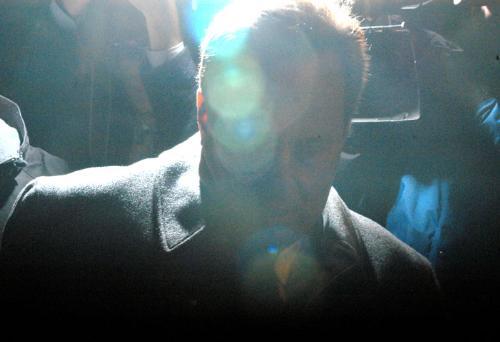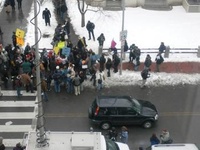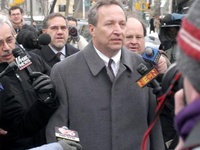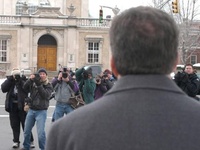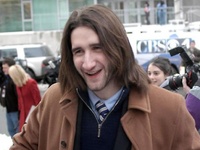Like paparazzi swarming around a rock star, dozens of reporters, cameramen, and photographers descended on Lowell Lecture Hall yesterday hoping to gain a glimpse—and a snapshot—of University President Lawrence H. Summers.
Even some members of the press corps were surprised by the size of the media circus at the corner of Kirkland and Oxford Streets yesterday. “A comment that may or may not have been sexist has 17 camera crews on it,” said an incredulous David Buswell-Wilde, a cameraman for the Boston-area ABC affiliate WCVB Channel 5.
Members of the media clutched cups of coffee from the Greenhouse Cafe and braved the bitter cold, pouncing on the few professors who trickled out early from the Faculty meeting yesterday evening. Inside the Science Center, freelance cameraman Tom Fahui, who had been contracted to cover the event for NBC, said the press presence “seems out of proportion.”
“The talk among the media is that this story is huge today because there’s not a lot else happening,” Fahui said.
But NBC producer Rick Brown vigorously disputed Fahui’s assertion. “Bush is overseas, dealing with the European countries. There’s plenty of news—believe me,” Brown said.
NBC had initially slotted a spot for the Harvard story on its flagship program “Nightly News” but altered its plans later in the day, Fahui said. “They’ve killed the story tonight,” Fahui said.
Brown said he thought the Faculty meeting would have drawn more media attention if professors had cast ballots on a motion expressing “no confidence” in Summers’ leadership. “No vote, no story,” Brown said.
The crowd outside Lowell Lecture Hall included some of the nation’s most prominent education journalists. Reporters from at least three Boston-area newspapers—the Globe, the Herald, and Metro—joined counterparts from at least four New York-based dailies—the Times, the Post, the Sun and the Wall Street Journal—as well as the Washington Post and the Associated Press.
Writers from the nation’s top three newsmagazines—Newsweek, Time, and U.S. News & World Report—and a slew of smaller periodicals—including the New Republic, the Weekly Standard, and the Chronicle of Higher Education—also staked out the scene.
At one point, the press corps outside Lowell Lecture Hall outnumbered the crowd of both pro-Summers and anti-Summers student activists. “Considering how important this is to Harvard, it’s amazing how few students are here, “ said Rick Friedman, a photographer for The Chronicle.
Matthew P. Downer ’07, president of the Harvard Republican Club and co-founder of the recently-formed Students for Larry, has emerged as a quasi-celebrity in the media maelstorm over the past several days. He said he had been giving “constant interviews” to reporters from an array of news outlets—including CNN’s William Schneider, a former associate professor of government at Harvard. Downer said his grandmother in St. Louis is keeping tapes of his television appearances—but his mentions in the media are becoming “too much to keep track of.”
Laura Crimaldi, a general assignment reporter for the Boston Herald, said she couldn’t think of any recent campus news stories that had garnered such extensive national media attention. But Rob Tomsho of the Wall Street Journal noted that comparably acrimonious spats between college presidents and faculty members had erupted recently at Baylor University—where President Robert B. Sloan Jr. resigned last month after two faculty votes of “no confidence”—and University of Southern Mississippi, where President Shelby Thames’ effort to fire two tenured professors touched off protests last spring.
In the end, the camera crews that jostled for space at the corner of Oxford and Kirkland proved ill-positioned for shots of Summers as he left the Faculty meeting last night. The University president followed an alternate route from the from Lowell Lecture Hall and proceeded onto Divinity Avenue.
—Staff writer Zachary M. Seward contributed to the reporting of this story.
—Staff writer Daniel J. Hemel can be reached at hemel@fas.harvard.edu.









